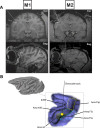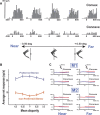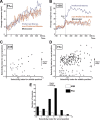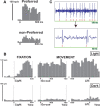Selectivity for three-dimensional shape and grasping-related activity in the macaque ventral premotor cortex
- PMID: 22933788
- PMCID: PMC6621512
- DOI: 10.1523/JNEUROSCI.1790-12.2012
Selectivity for three-dimensional shape and grasping-related activity in the macaque ventral premotor cortex
Abstract
Anatomical studies indicate that area F5 in the macaque ventral premotor cortex consists of three different sectors. One of these is F5a in the posterior bank of the inferior arcuate sulcus, but no functional characterization of F5a at the single-cell level exists. We investigated the neuronal selectivity for three-dimensional (3D) shape and grasping activity in F5a. In contrast to neighboring regions F5p and 45B, the great majority of F5a neurons showed selectivity for disparity-defined curved surfaces, and most neurons preserved this selectivity across positions in depth, indicating higher-order disparity selectivity. Thus, as predicted by monkey fMRI data, F5a neurons showed robust 3D-shape selectivity in the absence of a motor response. To investigate the relationship between disparity selectivity and grasping activity, we recorded from 3D-shape-selective F5a neurons during a visually guided grasping task and during grasping in the dark. F5a neurons encoding the depth profile of curved surfaces frequently responded during grasping of real-world objects in the light, but not in the dark, whereas nearby neurons were also active in the dark. The presence of 3D-shape-selective and "visual-dominant" neurons demonstrates that the F5a sector is distinct from neighboring regions of ventral premotor cortex, in line with recent anatomical connectivity studies.
Figures









Similar articles
-
Three-dimensional shape coding in grasping circuits: a comparison between the anterior intraparietal area and ventral premotor area F5a.J Cogn Neurosci. 2013 Mar;25(3):352-64. doi: 10.1162/jocn_a_00332. Epub 2012 Nov 28. J Cogn Neurosci. 2013. PMID: 23190325
-
Functional specialization of macaque premotor F5 subfields with respect to hand and mouth movements: A comparison of task and resting-state fMRI.Neuroimage. 2019 May 1;191:441-456. doi: 10.1016/j.neuroimage.2019.02.045. Epub 2019 Feb 23. Neuroimage. 2019. PMID: 30802514
-
The monkey ventral premotor cortex processes 3D shape from disparity.Neuroimage. 2009 Aug 1;47(1):262-72. doi: 10.1016/j.neuroimage.2009.04.043. Epub 2009 Apr 17. Neuroimage. 2009. PMID: 19376235
-
Shape representations in the primate dorsal visual stream.Front Comput Neurosci. 2015 Apr 22;9:43. doi: 10.3389/fncom.2015.00043. eCollection 2015. Front Comput Neurosci. 2015. PMID: 25954189 Free PMC article. Review.
-
Hierarchical Organization Within the Ventral Premotor Cortex of the Macaque Monkey.Neuroscience. 2018 Jul 1;382:127-143. doi: 10.1016/j.neuroscience.2018.04.033. Epub 2018 Apr 30. Neuroscience. 2018. PMID: 29715510 Review.
Cited by
-
Decoding a wide range of hand configurations from macaque motor, premotor, and parietal cortices.J Neurosci. 2015 Jan 21;35(3):1068-81. doi: 10.1523/JNEUROSCI.3594-14.2015. J Neurosci. 2015. PMID: 25609623 Free PMC article.
-
Object vision to hand action in macaque parietal, premotor, and motor cortices.Elife. 2016 Jul 26;5:e15278. doi: 10.7554/eLife.15278. Elife. 2016. PMID: 27458796 Free PMC article.
-
Coding of shape features in the macaque anterior intraparietal area.J Neurosci. 2014 Mar 12;34(11):4006-21. doi: 10.1523/JNEUROSCI.4095-13.2014. J Neurosci. 2014. PMID: 24623778 Free PMC article.
-
Single-cell responses to three-dimensional structure in a functionally defined patch in macaque area TEO.J Neurophysiol. 2018 Dec 1;120(6):2806-2818. doi: 10.1152/jn.00198.2018. Epub 2018 Sep 19. J Neurophysiol. 2018. PMID: 30230993 Free PMC article.
-
The neural mechanisms of manual dexterity.Nat Rev Neurosci. 2021 Dec;22(12):741-757. doi: 10.1038/s41583-021-00528-7. Epub 2021 Oct 28. Nat Rev Neurosci. 2021. PMID: 34711956 Free PMC article. Review.
References
-
- Belmalih A, Borra E, Contini M, Gerbella M, Rozzi S, Luppino G. Multimodal architectonic subdivision of the rostral part (area F5) of the macaque ventral premotor cortex. J Comp Neurol. 2009;512:183–217. - PubMed
-
- Borra E, Belmalih A, Calzavara R, Gerbella M, Murata A, Rozzi S, Luppino G. Cortical connections of the macaque anterior intraparietal (AIP) area. Cereb Cortex. 2008;18:1094–1111. - PubMed
-
- Castiello U, Begliomini C. The cortical control of visually guided grasping. Neuroscientist. 2008;14:157–170. - PubMed
-
- Fogassi L, Gallese V, Buccino G, Craighero L, Fadiga L, Rizzolatti G. Cortical mechanism for the visual guidance of hand grasping movements in the monkey: a reversible inactivation study. Brain. 2001;124:571–586. - PubMed
Publication types
MeSH terms
LinkOut - more resources
Full Text Sources
Miscellaneous
